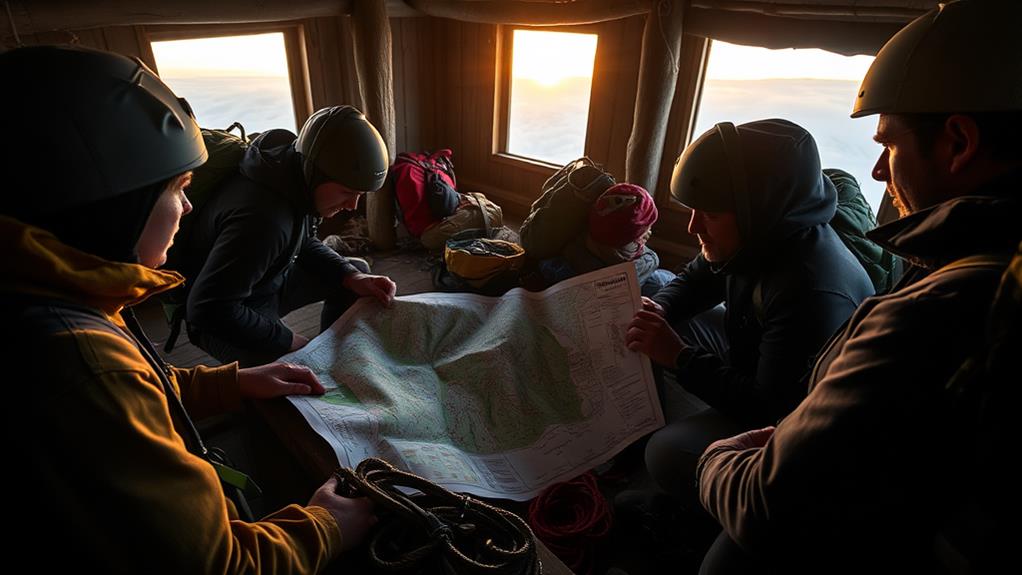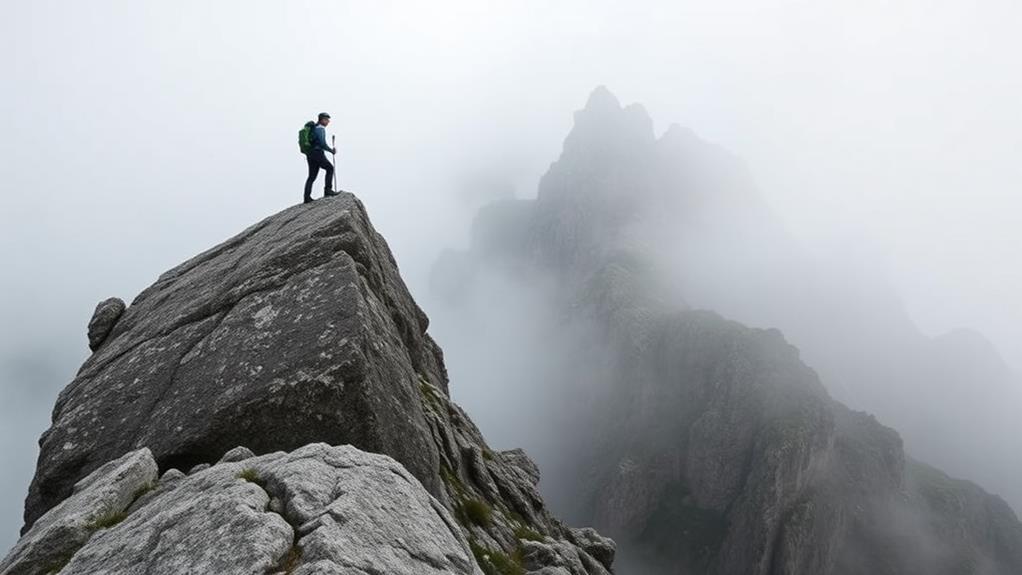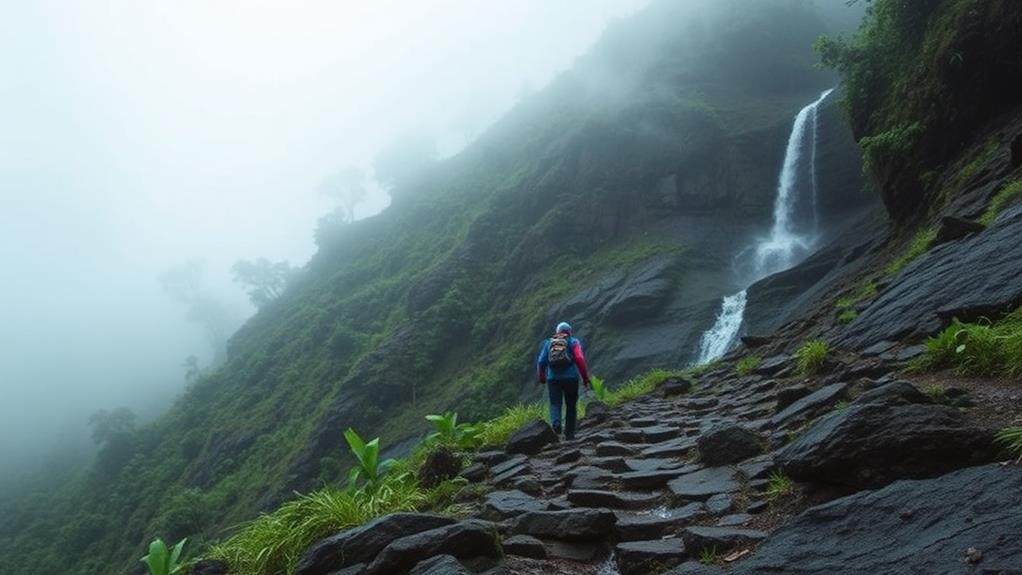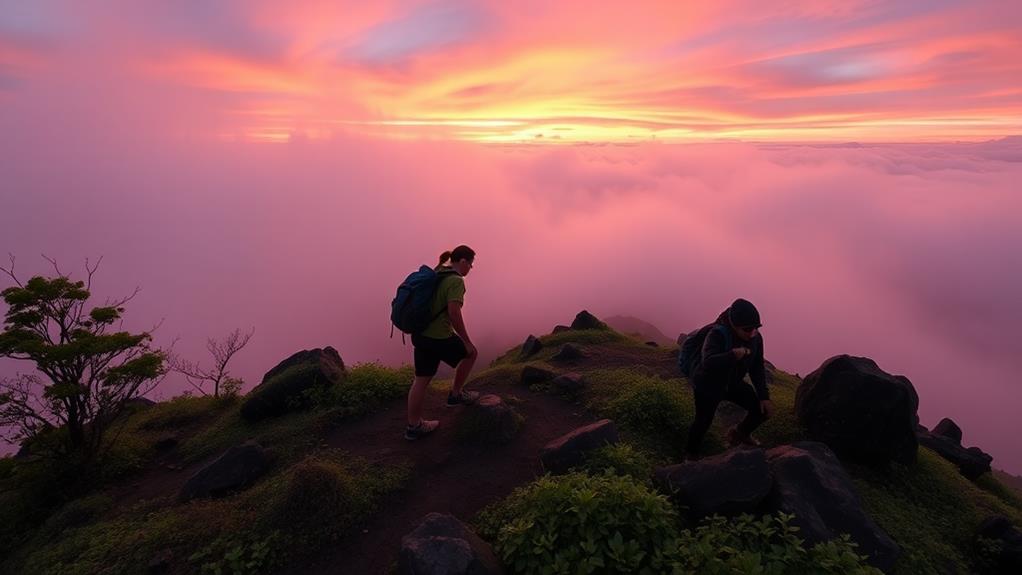Climbing Mount Apo: A Challenging Adventure
To reach the summit of Mount Apo, the highest peak in the Philippines, you need to be physically and mentally prepared. This requires securing necessary permits and medical documentation before embarking on the journey.
In Davao City, you will finalize your gear and meet with guides to ensure a safe and successful climb. However, be prepared for unexpected changes, such as the closure of the Sibulan Trail, which may require flexibility and additional documentation.
The trek to Mount Apo’s summit involves hiking through lush forests and boulder-filled terrains, as well as navigating unique geological features.
This challenging journey will test your endurance, but the breathtaking views from the summit and the sense of accomplishment make it a rewarding experience.
Preparing for the Summit

- Physical Training is Key
- To conquer Mount Apo’s towering peak, you need to be physically prepared. This means training for at least 2-3 months to build stamina and mental strength.
- Incorporate running and hiking with a load into your training routine to simulate the climb.
- Secure Necessary Documents
- Climbing permits and medical documentation are mandatory.
- Ensure you have medical certificates and ECG results to comply with local regulations.
- Pack Essential Gear
- Bring a lightweight camping tent, waterproof hiking shoes, and a well-fitted backpack to ensure a comfortable climb.
- Don’t forget to pack sufficient water and electrolytes, and take advantage of water sources along the trail.
- Manage Your Load
- To make the climb more comfortable, consider hiring porters to carry heavier gear, limiting your daily load to 8-10 kg.
- Mental Preparation is Crucial
- With the right mindset and preparation, you’ll be ready to tackle the grueling climb and conquer the highest peak in the Philippines.

Arrival in Davao City
Arrival in Davao City
Davao City is the main gateway to Mount Apo, located approximately 45 km southwest of the mountain. After arriving, settle into your accommodation, such as Park Avenue Residence Inn & Suites, which costs around P1600 for four persons.
Preparing for the Hike
Before heading to the trailhead, complete last-minute shopping at local stores like Robinsons-Bajada to stock up on essentials. Make sure you have everything you need for the hike.
Accommodation Options
| Accommodation | Cost | Capacity |
|---|---|---|
| Park Avenue Residence Inn & Suites | P1600 | 4 persons |
Finalizing Climbing Arrangements
In the evening, around 6:00 PM, meet up with friends or guides to finalize your climbing arrangements. Davao City provides access to various transport options for reaching the different trails leading to Mount Apo. Take this time to double-check your gear and make any necessary adjustments before embarking on your adventure.
The Unexpected Trail Change

Trail Changes Require Adaptability
When a meticulously planned hike takes an unexpected turn, flexibility is key. This was the case when arriving at Mt. Apo, only to discover that the Sibulan Trail was closed due to permit issues.
Alternative Trails and Documentation
The Digos/Kapatagan Trail was the alternative, but it required additional documentation, including medical certificates and ECG results, adding extra costs to the trek.
Pre-Trek Preparations
A break for breakfast in Digos allowed time for the necessary permits to be arranged.
Finally, at 3:00 PM, the trek commenced from Kapatagan.
Challenging Trail Conditions
The trail conditions were challenging, characterized by mud and obstacles resulting from recent rain.
Local Regulations and Safety
Local regulations emphasize strict adherence to littering policies and the requirement for certified guides with multiple ascents to ensure group safety.
With a certified guide, the rugged terrain of Mt. Apo was navigated, ready to face any challenges that lay ahead.
Trekking Through Diverse Landscapes
Embark on the Kapatagan Trail
You begin your adventure on the Kapatagan Trail, ready to explore Mt. Apo’s diverse landscapes. The trail takes you through lush mossy forests, boulder-filled terrains, and volcanic landscapes, offering scenic views of Davao del Sur and Davao Gulf. Along the way, you’ll pass unique landmarks like Lake Venado, the highest lake in the Philippines.
Diverse Flora and Fauna
As you hike, the trail transitions from farmland to dense forest, presenting climbers with diverse flora and fauna, including endemic species like the Philippine Eagle. This variety of plant and animal life is a hallmark of the region’s rich biodiversity.
Challenging Trail Conditions
Trail conditions vary significantly, with sections that may be steep and muddy due to rainfall, requiring careful navigation and physical endurance from trekkers. Climbers must be prepared for these challenges to reach the summit.
Geological Features
As you ascend, you’ll encounter notable geological features such as sulfur vents and giant boulders, which are indicative of the mountain’s volcanic activity. These features provide a glimpse into the mountain’s geological history.
Rewarding Experience
Throughout your journey, you’ll experience the rich biodiversity of the region, with the trail’s varying landscapes constantly surprising and challenging you.
The steep ascent will test your resolve, but the rewards are well worth the effort – breathtaking views, unique geological formations, and an unforgettable adventure await.
Challenges on the Boulder Face

Navigating the Boulder Face Requires Caution and Focus
Every step on the boulder face demands caution and attention due to the steep terrain and loose rocks. The path is treacherous, and each move must be deliberate to avoid accidents. The unique volcanic rock formations are breathtaking but intimidating, and it’s essential to stay focused on the path ahead.
Efficient Navigation is Crucial
Reaching the campsites before nightfall is essential, making efficient navigation vital. Time is of the essence, and every minute counts.
To ensure safe and timely progress, it’s crucial to communicate with group members, providing support and encouragement to maintain morale and safety.
Be Prepared for Hazardous Conditions
The boulder face can become slippery and hazardous in wet weather. Use trekking poles for extra stability in such conditions.
The boulder walls loom above, a testament to the mountain’s power, but with careful planning and execution, you’ll overcome this challenge.
Stay Focused to Emerge Victorious
Stay focused, and you’ll emerge victorious on the other side, ready to take on the next stage of your Mt. Apo adventure.
Conquering the Highest Peak
Conquering Mount Apo’s Summit
Reaching the highest point in the Philippines, Mount Apo’s summit, requires determination, physical endurance, and mental toughness. From the top, you’ll be rewarded with breathtaking views of diverse ecosystems and a sea of clouds stretching as far as the eye can see.
Choosing the Right Trail
To reach the summit, you’ll need to select one of two trails: the Kapatagan Trail or the Sta. Cruz-Kidapawan Trail. Both trails offer unique challenges and scenic vistas.
Be prepared for a 6-8 hour trek with significant elevation gain, navigating steep inclines and boulder faces along the way.
Preparation is Key
Before embarking on your journey, secure permits and medical documentation, including ECG results.
Be prepared for varying terrain conditions, including steep inclines and boulder faces. The breathtaking views of the crater and surrounding landscapes are a rewarding highlight of the journey.
Descending Through Fog and Rain

Descending Through Fog and Rain
Fog and rain drastically reduce visibility as you descend from Mount Apo’s summit, requiring careful navigation to avoid accidents. Every step demands attention to prevent slips and trips on the narrow trails.
Maintaining Safety
To ensure a safe descent, it’s essential to maintain a steady pace. This allows you to navigate through the fog and rain without taking unnecessary risks. GPS strategies can be helpful, but it’s crucial to be aware of the trail layout and potential hazards.
Overcoming Challenges
| Challenge | Strategy | Tips |
|---|---|---|
| Reduced Visibility | GPS Navigation | Bring spare batteries and keep devices dry |
| Slippery Terrain | Trekking Poles | Use poles for stability and knee protection |
| Communication | Teamwork | Designate a lead climber and stay within earshot |
| Muddy Sections | Steady Pace | Take small steps and avoid sudden movements |
Importance of Teamwork
Communication among group members is key to managing challenges posed by the weather and terrain. Teamwork can make all the difference by having a clear plan in place and working together to overcome obstacles.
Bonding Moments at White Sand Camp
White Sand Camp: A Haven for Bonding Moments
After a challenging descent through fog and rain, White Sand Camp offers a serene oasis where fellow climbers can form lasting bonds.
This tranquil atmosphere fosters camaraderie among trekkers, providing more than just a place to rest.
Sharing Experiences
- Share meals and drinks around the campfire, swapping stories and laughter that create a sense of community among strangers-turned-friends.
- Take a moment to stargaze, lying on your back and marveling at the twinkling night sky.
Early Morning Reflections
* Rise early to witness the mystical mist-covered landscape, with Mt. Apo’s reflection staring back at you from the nearby lake – a perfect setting for quiet reflection and contemplation.
Emotional Connections
The shared experience of overcoming challenges during the climb enhances the emotional connections formed at White Sand Camp, making it a memorable highlight of your journey to the roof of the Philippines.
Overcoming Obstacles Together

Conquering Mount Apo’s rugged terrain requires teamwork and effective communication. Climbers must navigate steep slopes, unpredictable weather, and physical exhaustion together.
Individual strength isn’t enough; overcoming these challenges demands collaboration and trust among team members.
Experienced local guides, or “kuyas,” provide essential support and guidance. They assist during the toughest sections of the trail, allowing climbers to focus on the climb rather than worrying about gear.
Helpful porters carry the weight of equipment, further reducing the burden on climbers.
As climbers face each obstacle together, a sense of camaraderie develops. This supportive environment motivates team members to encourage and push each other to overcome challenges.
Overcoming obstacles not only strengthens physical abilities but also deepens emotional connections and shared memories among climbers.
What are the similarities and differences between hiking Mount Apo and hiking Mount Guiting-Guiting?
Hiking Mount Apo and Mount Guiting-Guiting both offer a challenging climb for hikers. However, Mount Apo is known for its easier trails and wider slopes, while Mount Guiting-Guiting is famous for its narrow ridges and steep cliffs. Both provide stunning views and a rewarding experience for adventurous hikers.
Reflecting on the Journey Down
The Descent from Mt. Apo
Duration and Preparation
The journey down from Mt. Apo takes 5-6 hours of continuous movement, requiring caution on slippery trails and maintaining communication among group members.
Navigating Challenges
- Fog and rain can lead to slips and trips along narrow paths, making it essential to navigate carefully.
- Rely on your guide’s expertise, as they’ve undergone multiple ascents to Mt. Apo for certification and are familiar with the terrain.
Trail Challenges
The trail down to Lake Venado can be particularly tricky, with steep sections that demand your attention and pace.
Safety and Group Dynamics
Safety is paramount during the descent, and your group’s dynamics play a crucial role in ensuring a successful journey.
Reflection and Connection
Once you’ve completed the descent, you’ll have a chance to reflect on your experience, sharing stories and expressing gratitude for the emotional connections formed during the hike.
Frequently Asked Questions
How Hard Is It to Climb a Mt. Apo?
Climbing Mt. Apo requires serious preparation and planning.
Altitude sickness is a significant risk, so acclimatization is crucial. It’s essential to hire a local guide who can ensure your safety and keep you on track.
Sturdy gear is mandatory, including waterproof equipment and robust boots, to navigate the muddy trails.
The best time to climb is during the dry months, but be prepared for difficult trails and rapidly changing weather conditions.
Safety measures are paramount, so it’s vital to take necessary precautions and avoid taking any chances.
What Is the Most Beautiful Mountain to Hike in the Philippines?
Mount Pulag is the most beautiful mountain to hike in the Philippines, offering scenic views, opportunities for wildlife encounters, and cultural significance.
This mountain trail provides breathtaking scenery, including the famous “Sea of Clouds” sunrise view from the summit.
Hikers can spot various wildlife species, such as the Philippine deer and the Benguet pine tree. The mountain is also home to several ethnic tribes, including the Kabayan and the Kalanguya, who’ve lived in the area for centuries.
To ensure a successful hike, hikers should wear appropriate gear, including sturdy hiking shoes and layers of clothing, and consider hiring a local guide who’s familiar with the terrain and cultural traditions.
Remember to bring a camera to capture the stunning views and respect the environment by following responsible hiking practices and supporting conservation efforts.
What Is the Best Trail to Mount Apo?
Choosing the Best Trail to Mount Apo
When selecting a trail, consider trail difficulty levels, safety precautions, and guided tours.
The Kapatagan Trail is a great option because it offers a mix of ecosystems and accessibility for all skill levels. This trail is suitable for hikers of various experience levels, from beginners to experts.
Pack the right gear to ensure a safe and enjoyable hike. Bring essential items such as sturdy hiking boots, comfortable clothing, and a first-aid kit.
Be prepared for varying weather conditions, including rain, heat, and wind. Check the weather forecast before your trip and pack accordingly.
Along the way, take in the stunning local flora and scenic views. Mount Apo is home to a diverse range of plant species, including tropical rainforest and mossy forest ecosystems.
Set up camp at one of the many camping spots, which are available throughout the trail. These campsites offer a convenient place to rest and recharge for the night.
Is Mt. Apo the Mountain With Highest Peak in the Philippines?
Mt. Apo is the mountain with the highest peak in the Philippines, with an elevation of 2,954 meters.
This makes it the country’s highest point.
As a biodiversity hotspot, Mt. Apo features unique ecosystems and volcanic activity, earning it a sacred status among locals.